Got a floor, a chair, and a little time? You can build strength, boost cardio, and feel better, all with your own body. This guide gives you a simple plan to follow for 8 weeks. You will get a weekly schedule, form tips, and ways to track progress. If you want to improve fitness with calisthenics program, you are in the right place.
This plan fits busy beginners and early intermediates. Work out at home, a park, or while traveling. No machines, no crowd, no guesswork. You will learn the moves, how to progress, and how to measure results. Keep it consistent, keep it simple, and watch your fitness climb.
Calisthenics 101: why bodyweight training boosts total fitness
Bodyweight training builds strength, stamina, and control. You learn to move your body well, not just lift a weight. That carries over to daily life, sports, and work.
Build strength and muscle without a gym
Push, pull, squat, and brace. These four patterns train your chest, back, legs, and core. Use progressive overload with harder variations, more reps, slower tempo, or shorter rest. You can grow muscle and strength with basics, if you increase the challenge over time.
Cardio and core benefits you can feel
Circuits raise your heart rate and build endurance. They burn calories and improve recovery. Planks, hollow holds, and carries train your core, which supports posture and helps your back. Use the talk test. You should speak in short phrases, not full sentences, during work sets.
Mobility, balance, and joint health for daily life
Controlled range of motion builds mobility and control. Single leg work boosts balance and coordination. Better movement patterns reduce aches in knees, hips, and shoulders. Your body learns to share stress across joints so you feel better.
Save time and money with workouts anywhere
No gear needed, quick setup, flexible locations. Train at home, at a park, or on the road. Short, focused sessions beat long, random workouts. You get more done in less time when the plan is clear. Now, let’s build yours.
Design a calisthenics program that fits your goals and schedule
A good plan is simple, repeatable, and easy to track. Set a clear goal, pick a weekly schedule you can keep, choose core moves, and adjust every two weeks. Use short, focused sessions. Keep the barrier low so you show up.
Check your start and set simple SMART goals
Test four things. Max push ups in 2 minutes. A 30 to 60 second dead hang or max supported row reps. A 1 mile walk or run time. A 30 to 60 second plank. Set SMART goals for 8 weeks. For example, add 15 push ups, cut 1 minute from your mile, row 10 more reps, and hold a 60 second plank. Write them down.
Pick a weekly split and plan rest days you will keep
Choose one. Three days full body, Monday, Wednesday, Friday. Or four days, upper and lower split. Book at least one full rest day. Block 30 to 45 minutes per session. Plan sleep into the week. If a day gets busy, cut volume, not the session. Show up and do fewer sets.
Choose the core moves for a full body plan (push, pull, legs, core)
Pick one per pattern. Push ups or incline push ups. Rows under a sturdy table, pull ups, or band assisted. Squats and lunges. Hip hinge like glute bridge. Planks or hollow holds. Use easier versions if form breaks. Try harder versions when ready. Control tempo, for example 3 seconds down, 1 second up.
Track progress and adjust your plan every 2 weeks
Use a simple log. Record sets, reps, RPE from 1 to 10, and time. If all sets are under RPE 8, add 1 to 2 reps next time or choose a harder version. Retest your push ups, mile, rows or hang, and plank every two weeks. Adjust your goal if you are ahead or behind.
8 week plan: improve fitness with calisthenics program
This roadmap gives you structure and built-in progress. Use an RPE of 6 to 8 for most sets. Keep rest short but steady. Do three days per week if you are new. If you feel fresh, add a light fourth day of mobility and walking.
Weeks 1 to 2: build a base with a simple full body circuit
Alternate Workout A and B, three days per week.
- Example circuit, 3 rounds:
- Incline push ups, 3×8 to 10
- Bodyweight rows under table, 3×6 to 8, or band rows
- Squats, 3×10 to 12
- Glute bridge, 3×12 to 15
- Plank, 3×30 seconds
Rest 60 to 90 seconds between moves, RPE 6 to 7. Move with control. If time allows, add a 10 minute brisk walk after.
Weeks 3 to 4: add volume and easy progressions
If form is solid, shift from incline to regular push ups. For rows, add reps or slow your lower for 3 seconds. For squats, pause 2 seconds at the bottom. Plank moves to 3×40 to 45 seconds. Do 4 total rounds. Rest 60 seconds. Work at RPE 7 to 8. Optional finisher, 5 minutes of 30 seconds jumping jacks, 30 seconds rest.
Weeks 5 to 6: increase intensity and learn new skills
Push ups, 4×10 to 12. Try diamond push ups for the last set if you are ready. Pull pattern, move your feet farther out on table rows or try band assisted pull ups, 4×6 to 8. Legs, reverse lunges, 3×10 each leg, 3 second lower. Core, hollow hold, 3×20 to 30 seconds. Add a short EMOM for 6 minutes, 5 burpees or step back burpees at an easy pace.
Weeks 7 to 8: push your best, then test and deload
Week 7, keep form strict and work at RPE 8. Try harder progressions like pike push ups, assisted pull ups, split squats, side planks. Week 8 is test week. Do max push ups in 2 minutes, your best 1 mile time, and your longest plank. Deload the last 3 to 4 days. Cut sets in half, keep moves easy, and focus on clean reps.
Master form, recovery, and nutrition for faster results
Good form adds power and protects you. Recovery habits drive progress. Eat well, sleep enough, and keep your plan steady. Small steps add up fast.
Form cues for key moves so you stay safe
Push up, wrists under shoulders, ribs down, body in a straight line. Row or pull up, lead with elbows, squeeze your shoulder blades, keep your neck long. Squat and lunge, knees track over toes, chest tall, heels down. Plank and hollow, brace ribs to hips, breathe through the nose when you can.
Use smart progressions (the 2 rep rule and RPE)
If you finish all sets with 2 clean reps left, pick a harder version next time. Use RPE 6 to 8 for most sets. Save RPE 9 for test days. Change only one variable at a time. Add reps, sets, slow the tempo, or cut rest. Keep one knob turning so you can track what works.
Recovery basics: sleep, protein, hydration, and mobility
Sleep 7 to 9 hours. Eat protein at each meal, about a palm or 0.7 to 1 gram per pound per day, adjust to your needs. Drink water through the day until urine is pale yellow. After sessions, add 5 to 10 minutes of light mobility for hips, shoulders, and spine. Walk on rest days to keep blood flowing.
Avoid common mistakes that slow your gains
Do not rush reps or skip warm ups. Do not add hard skills too fast. Do not train to failure every day. Do not copy pro routines. Keep form clean, progress steady, and take rest days seriously. Show up, log your work, and let the plan do its job.
Conclusion
You now have a clear path, from simple tests to SMART goals, a weekly schedule you can keep, an 8 week plan, and recovery habits that support growth. Start today with Day 1. Log your first test, then set one small win to hit in the next 14 days. If you want to improve fitness with calisthenics program, follow the steps and keep the effort steady. Small sessions stack into big results. Ready to move? Lace up, press start on a timer, and get your first round done.
Related post:
- Deltoid Bodyweight Exercise Guide
- Easy Stretching Exercises for Sciatica
- Best Workout to Lose Stomach Fat
Improve Fitness With Calisthenics Program FAQs:
What results can I expect from a calisthenics program?
You can gain strength, muscle tone, endurance, and better joint control. Expect improved posture, balance, and mobility. Fat loss depends on your diet and total activity.
How many days per week should I train?
Start with 3 days per week on nonconsecutive days. Move to 4 or 5 days as you recover well. Keep at least one full rest day.
How long should a session take?
Aim for 45 to 75 minutes, including warm-up and cooldown. Short on time? Do 25 to 30 minutes with higher focus and shorter rests.
Do I need equipment to start?
No. Use the floor, a sturdy table, and a doorframe. A pull-up bar, rings, and resistance bands expand options and progress.
How do I progress without weights?
Increase reps, sets, or total volume. Slow the tempo, add pauses, or use harder variations. Decrease rest or move to unilateral work like pistol squat progressions.
What’s a good beginner routine?
Focus on push, pull, squat, hinge, and core.
- Push-ups or incline push-ups
- Rows or band rows
- Bodyweight squats
- Hip hinges or glute bridges
- Planks and hollow holds Do 3 sets of 6 to 12 reps per move, 3 days per week.
How do I warm up properly?
Do 5 to 10 minutes of light cardio, then joint circles. Add dynamic moves like leg swings, band pull-aparts, and scapular push-ups. Finish with 1 or 2 easy sets of your first exercise.
Will calisthenics build muscle?
Yes, if you train near fatigue and progress weekly. Use 6 to 20 reps per set, 8 to 15 total hard sets per muscle per week, and eat enough protein.
How much protein do I need?
Aim for 0.7 to 1.0 grams per pound of body weight daily. Spread protein across 3 to 5 meals. Include lean meat, eggs, dairy, tofu, beans, and protein powders.
Can I lose fat with calisthenics?
Yes. Pair training with a small calorie deficit, about 300 to 500 calories per day. Keep protein high and add steps or short cardio sessions.
I can’t do a pull-up yet. What’s the path?
Use band-assisted pull-ups, negative reps, and Australian rows. Train 2 to 3 times per week. Grease the groove with frequent low-rep sets. Track your best max set monthly.
Push-ups hurt my wrists. What should I do?
Use push-up handles, dumbbells, or fists to keep wrists neutral. Warm up with wrist circles and gentle stretches. Start on an incline to reduce load.
Are pistol squats safe for my knees?
They can be, with smart progressions. Start with box pistols, assisted reps, and slow tempo. Strengthen glutes and hamstrings. Stop if you feel sharp pain.
How do I avoid plateaus?
Plan progression. Rotate variations every 4 to 6 weeks, like from incline push-ups to standard to decline. Add volume or reduce rest. Deload for one lighter week every 6 to 10 weeks.
What’s the best split for calisthenics?
Three options work well:
- Full body, 3 days per week
- Upper, lower, upper, lower, 4 days per week
- Push, pull, legs, 3 to 6 days per week Pick one that fits your schedule and recovery.
How much rest between sets?
Take 60 to 90 seconds for moderate work. Take 2 to 3 minutes for heavy sets or hard skills. Shorter rest raises the burn but may reduce strength.
How do I train my core effectively?
Use anti-extension, anti-rotation, and flexion work. Examples: dead bugs, planks, hollow holds, ab wheel, hanging knee raises, side planks. Train core 3 to 5 times per week.
Is cardio needed if I do calisthenics?
Yes for heart health and recovery. Add 2 to 3 sessions of 20 to 40 minutes easy cardio, like brisk walking or cycling. Short sprints once a week help conditioning.
How soon will I see results?
Most people feel stronger in 2 to 4 weeks. Visible changes often show by 6 to 12 weeks with steady training and nutrition.
Can older adults do calisthenics?
Yes. Use controlled tempo, more warm-up, and joint-friendly options. Focus on balance and mobility. Progress slowly and monitor recovery.
What if I’m overweight or new to exercise?
Start with chair or wall variations and short sessions. Walk daily and track steps. Celebrate small wins, like one extra rep per week.
How do I learn skills like handstands or muscle-ups?
Break them into parts. For handstands, practice wall holds, shoulder taps, and wrist prep. For muscle-ups, build strict pull-ups and deep ring dips. Practice 3 to 5 short skill sets after warm-up.
How do I prevent injuries?
Use full range of motion you control. Warm up, progress gradually, and stop before form breaks. Sleep 7 to 9 hours and schedule rest days.
What should I eat around workouts?
Have a balanced meal 1 to 3 hours before, with carbs and protein. After training, eat protein within a few hours and include carbs to refill energy.
Can I mix calisthenics with weights?
Yes. Use weights for lower body strength or to target weak points. Keep key skills first when fresh, then add weighted lifts or accessories.
How do I track progress?
Log reps, sets, and variations. Record max holds for planks and handstands. Take monthly photos and note energy, sleep, and recovery.
Do I need to stretch after workouts?
Yes, 5 to 10 minutes helps mobility and relaxation. Hold stretches for 20 to 40 seconds. Focus on shoulders, hips, hamstrings, and calves.
What if I have joint pain?
Reduce range of motion and use easier regressions. Strengthen supporting muscles and check form. If pain persists, stop and talk with a qualified clinician.
What’s a simple weekly template I can follow?
- Day 1: Push, pull, core
- Day 2: Lower, core, light cardio
- Day 3: Rest or walk
- Day 4: Push, pull, core
- Day 5: Lower, core, intervals
- Day 6: Skills, mobility, light cardio
- Day 7: Rest
How much mobility work should I do?
5 to 10 minutes daily keeps joints happy. Add longer sessions twice a week for problem areas.
Can I train when traveling?
Yes. Use bodyweight circuits in small spaces. Pack a light band and use a hotel doorframe for rows or strap a portable bar.
Do I need to take supplements?
Not required. Protein powder is convenient. Creatine monohydrate can boost strength and power. Check with your doctor if you have health concerns.
How do I stay consistent?
Schedule sessions, set small targets, and track wins. Keep workouts simple on busy days. Find a plan you enjoy so you stick with it.




 Fitness Tips for Busy Professionals
Fitness Tips for Busy Professionals 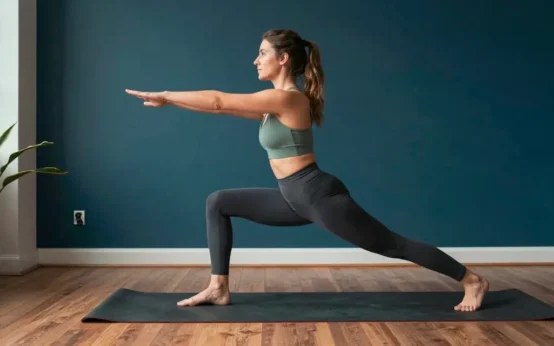 Beginner Cardio Workout at Home
Beginner Cardio Workout at Home 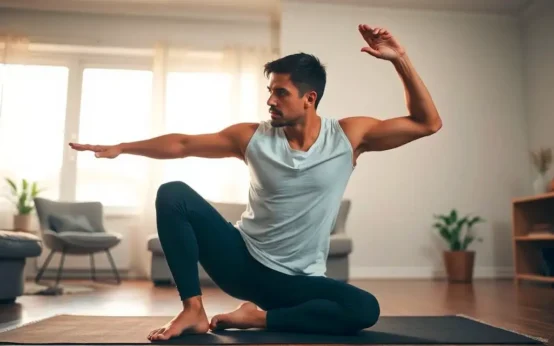 10 Stretching Exercises to Increase Height
10 Stretching Exercises to Increase Height 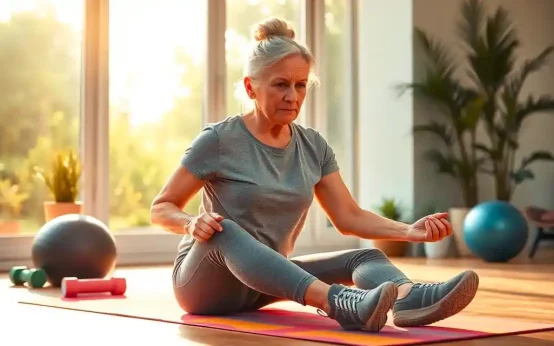 Menopause Workout: A Simple, Strong Plan
Menopause Workout: A Simple, Strong Plan 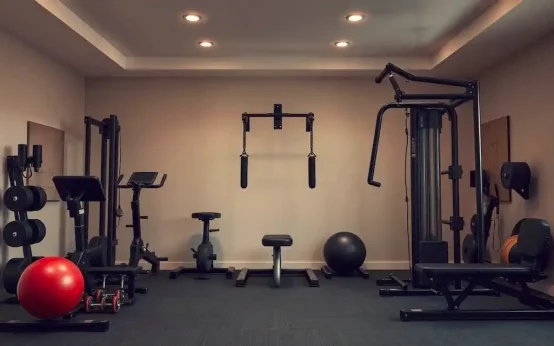 Best Home Gym Workout Equipment
Best Home Gym Workout Equipment 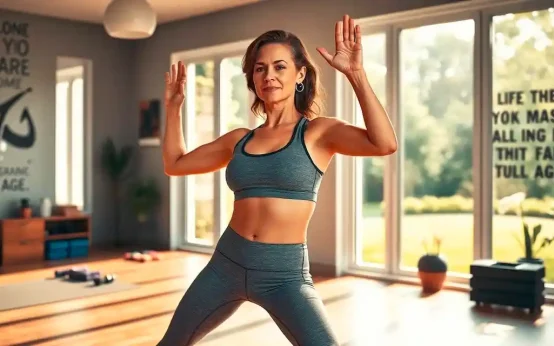 Exercise Tips Help You Look Great for Your Age
Exercise Tips Help You Look Great for Your Age